Indoor Hanging Plants: [15 Examples + Care, Watering and Substrate]
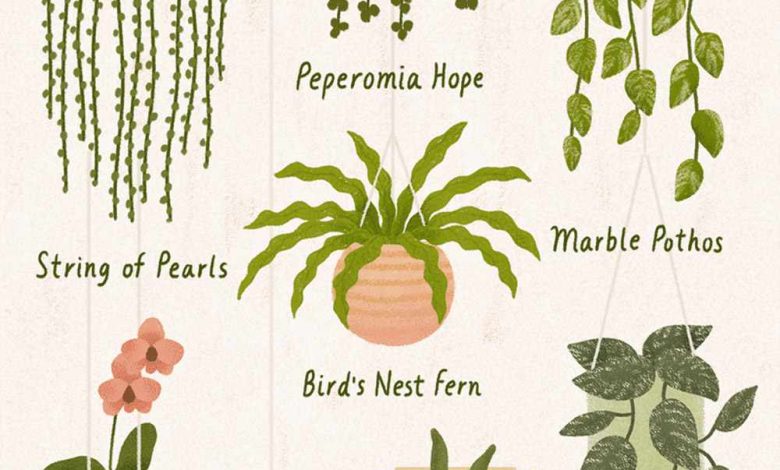
Indoor hanging plants are perfect for any room in the house.
Essential to brighten our lives, purify environments and decorate that special corner where it may be necessary to make some adjustments to emulate a tropical jungle or warm climate, with lots of natural light or semi-shade.
They are faithful, relaxing, colorful, some with unusual leaves and cascading stems that, although they require minimal care, attention that is not so complicated as long as we put our heart into the noble job of gardening.
Entering the fascinating world of hanging plants is a privilege that we will share with you, in a simple tour where we will learn all about 15 spectacular indoor hanging plants that will never disappoint you.
donkey’s tail
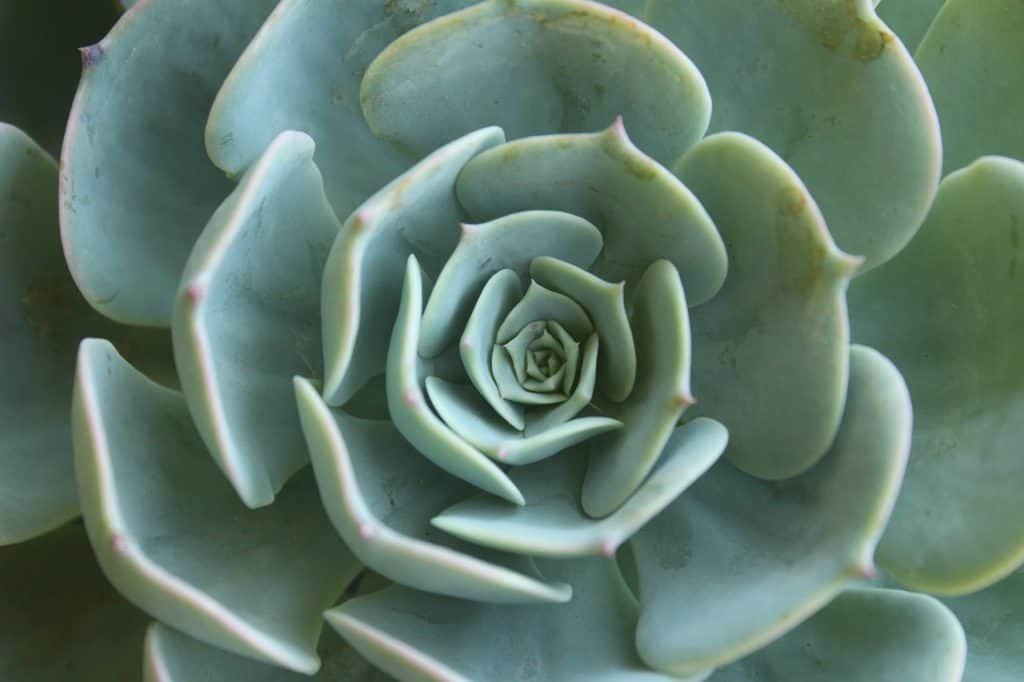
The Donkey’s Tail, whose scientific name is Sedum morganianum, is a succulent plant that belongs to the Crasulaceae family. Its origin is Mexican.
It is also known as Borrego’s Tail or Drunkard’s Nose and it really is sensational to grow it in hanging baskets to decorate very special spaces in your home. Therefore, it can be a very good alternative as a hanging indoor plant.
It is made up of a succession of almost cylindrical leaves of a grayish green tone that hang thanks to their long stems with a beautiful fall.
These characteristicsmake it a perfect indoor plant for the inexperienced. It is also very, very resistant.
It does not require great care. Its cultivation is only required in a pot with very good drainage that you should locate somewhere with a good elevation when its stems reach full growth, in order to protect its unique leaves.
Pink flowers sprout in spring and summer at the end of the stems, but this rarely happens, unless it is stimulated by taking it out in the sun during the summer days.
Another characteristic that identifies it is that it reproduces very easily, because you only have to take a cutting and stick it in the moistened substrate. Soon a new plant will be born which, to be honest, will be quiteself-sufficient and will not require great care.
We see what are the minimum needs of this American plant capable of storing water in its unique leaves.
Temperature
Burro ‘s Tail is superior to many other succulents in adapting to high temperatures.He likes the heat. But it also tolerates minimum temperatures that oscillate between 5 to 7°C.
However, it is not a bad idea to help it rest in the winter, when you should keep it in rather cool areas that will keep its leaves full of water.
Light
Undoubtedly,a priority for her is the need to receive generous indirect light.
Although it is true that it cannot stand exposure to strong sunlight, this plant requires at least 4 hours of indirect sunlight. If that does not happen, you will notice how its leaves will dry out until they lose their shine and shape. It will not grow and will look very pale indeed.
Substrate and Fertilizer
Fertilize the Sedum Morganianum two or three times a year, because although it is true that its maintenance is minimal, it must be stimulated so that its foliage is fruitful.
An excellent fertilizer will help a lot about twice a year. But if you notice that it has grown a lot then you should move it to a larger pot.
And as for the substrate, search the market for one for cacti. Or prepare one with your own hands, adding to a universal type substrate, perlite and sand in equal parts.
Renewing the substrate should also be done in a period of two or three years.
But the most important thing really is to achieve the best drainage, becausethe roots of the Cola de burro rot with total ease and speed.
Excess moisture is your worst enemy.
Irrigation
As we have already explained, the great capacity it has to store water is directly proportional to the little irrigation it requires.
Once every 15 days will be prudent in spring or summer. Otherwise, you would spoil their leaves. And the substrate must always have dried before undertaking a new irrigation. Always check it with the help of your sense of touch.
In the winter, the plant goes into excess and does not grow. Just water it once a month. No more of that. And here it is much more important that the drainage of the pot is perfect, achieving a fluid filtering of excess water, without the soil being overflowed.
As for the time to reproduce it, wait until spring arrives and the temperatures are mild. The cuttings will take quickly if the substrate is suitable.
They have great rooting abilities. A good time to do this is when some of its leaves begin to shed. That’s where the transplant comes from.
As long as you grow it in a hanging pot with optimal drainage, you will obtain excellent results that will be the healthy envy of anyone who observes this beautiful low-maintenance succulent plant with a high ornamental value, thanks to its imposing presence.
tradescantia
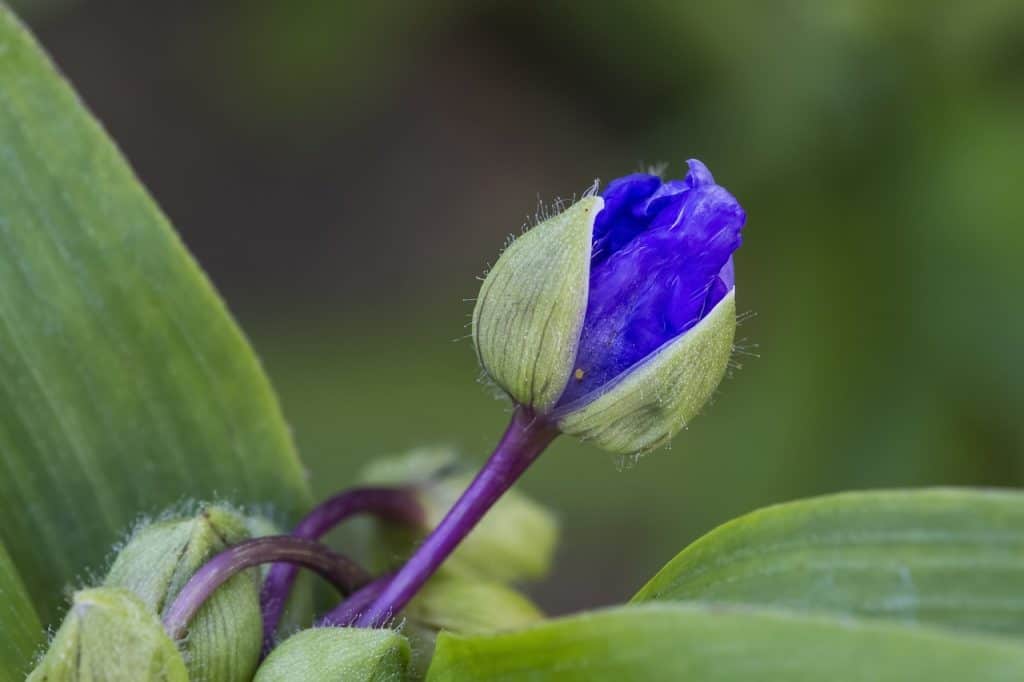
Another noble plant that can thrive in hanging pots or at ground level given its creeping condition, is the Tradescantia (Tradescantia pallida) better known as glitter or love of men.
Nor does it require more attention or care.
Originally from Mexico, it has had an amazing ability to cross borders and multiply throughout the world with great adaptability to environments different from its place of origin.
It is one of the favorites when it comes to achieving colorful contrasts, thanks toits purple leaves with edges in a unique pinkish tone and very summery pink inflorescences.
Its hanging cut can be used indoors, as long as you use pots to create upholstery effects in naturally lit areas.
Ideal for beginners in the fascinating world of gardening, the Tradescantia is low in maintenance. It doesn’t ask for much.
It is really versatile.Responde muy bien si la sometes a un crecimiento colgante, o como ejemplar “cubresuelos” en el jardín de tu hogar, creando alfombras perfectas con su follaje expansivo de raíces que brotan entre sus nudos, lo cual le permite adherirse bien a la superficie que invade.
Las especies más populares, la tradescantia purpurea, la zebrina, la spathacea virginiana o la sillamontana, son leales a su fortaleza de hierro.
También está bien que sepas que hay más de 70 especies de este género,Almost all of them come from the American continent, from Canada, to the north, to Argentina, to the south. Species that have achieved worldwide recognition, given their great ability to interbreed and create hybrids naturally.
There are those who use hormones to stimulate rooting, but in reality its reproduction by cuttings is of a superior response in this plant, especially in the period between spring and autumn.
Temperature
Minimum values between12 to 15°C will be enough for it to develop. And low humidity.
Es tan noble que se puede amoldar a tiempos de sequía, dado su bajo mantenimiento, pero no puede vivir entre nevadas o temperaturas inferiores a -3°C.
Luz
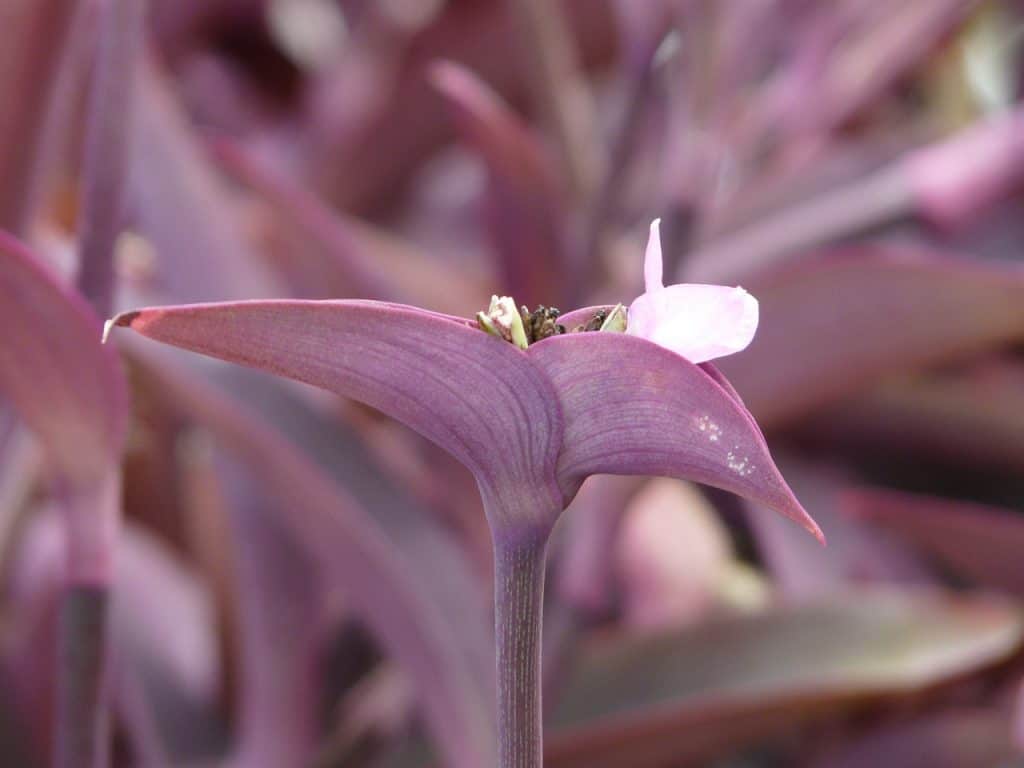 La buena luz natural es fundamental en su larga existencia. De no ser así, sus hojas perderán vistosidad, se decolorarán hasta verse desteñidas y caídas.
La buena luz natural es fundamental en su larga existencia. De no ser así, sus hojas perderán vistosidad, se decolorarán hasta verse desteñidas y caídas.
En síntesis, abundante luz para expandirse, crecer y florecer. Pero también se lleva de maravillas con la sombra, siempre que no se prolongue tanto.
Sustrato y Abono
Usa fertilizantes líquidos cada 15 días en el agua de riego, en la primavera, si es que deseas estimular su belleza con un buen abono mientras la Tradescantia crece.
In the rest period of the plant, it will be very appropriate to apply fertilizers every three weeks or a little more.
And all the unproductive parts of the plant steal energy from it, so, with great care, carry out a pruning that does not affect the growth of its branches.
Irrigation
potted,The fluid drainage is transcendental so that the water does not puddle the substrate.Between watering and watering, the soil must always be dry, both indoors, as in gardens and balconies.
Always watch this variable, or you will lose a great ally.
Only in the summer, water the substrate twice a week and every ten days or more in the winter period.
And take care of diseases caused by the presence of high humidity, since the stems rot like their roots, due to a gray mold that also invades their leaves. Eliminate the diseased areas and you will see that it will recover quickly to show you all its purple splendor.
The Ivy (Hedera Helix)
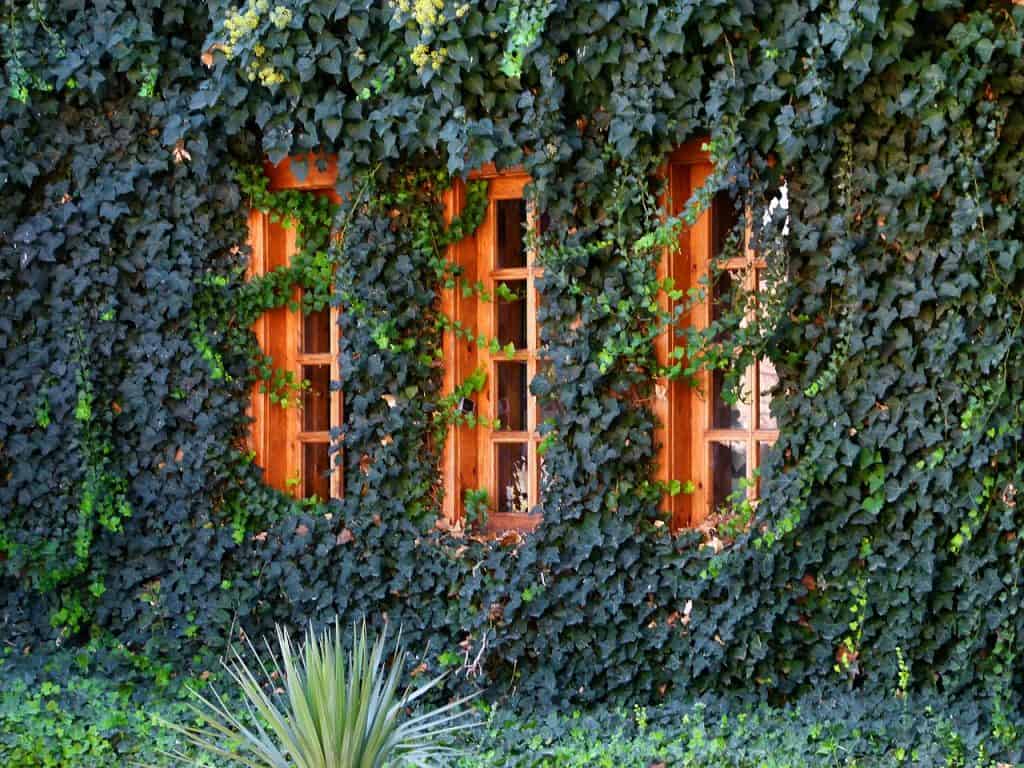
The Common Ivy or Hedera Helix, together with the Canariensis or Canary Ivy, are varieties created especially by nature to be grown in warm interiors, where their leaves painted with white and gold nuances multiply without any problem in many homes on the European continent. Where does this plant come from that demands little and gives a lot.
It has spread to North Africa, the Canary Islands, Japan and Central Asia. It can be a good option inside as a hanging indoor plant in your house, although be careful because it expands easily.
There are currently around 15 identified types, where, in addition to the common and the Canarian, species such as: Hedera colchica (Caucasian ivy), Hedera maroccana, Hedera algeriensis (Algerian ivy), Hedera nepalensis (Nepal ivy) stand out.
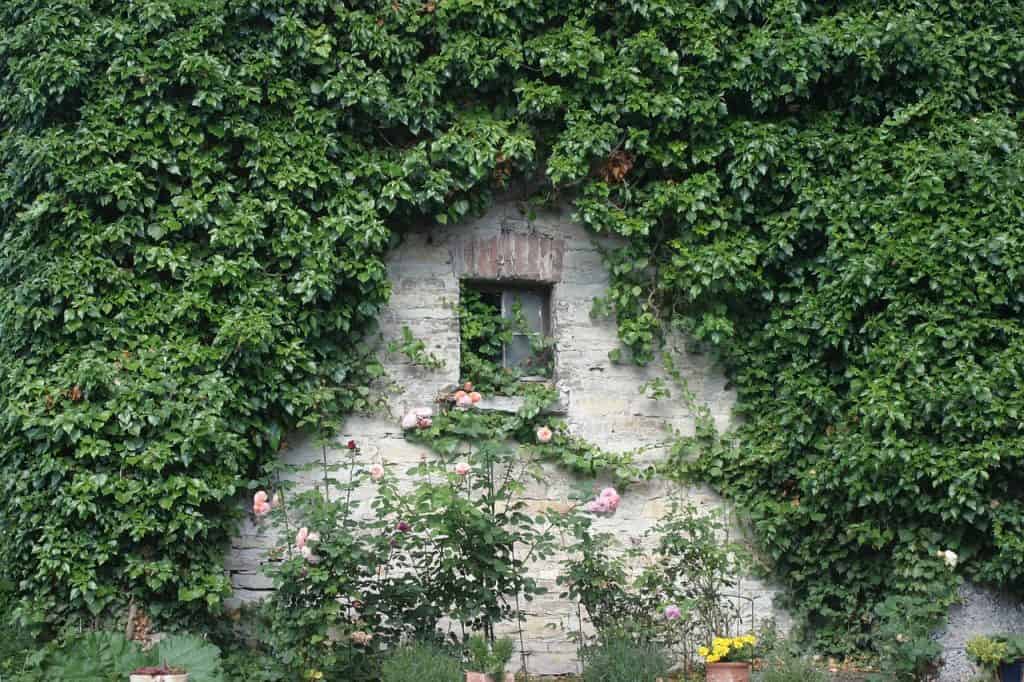 This ornamental plant, special for decorating environments, belongs to the Araliaceae family and outdoors it also works very well, but never waste its great potential to be molded into vertical or horizontal hanging gardens.
This ornamental plant, special for decorating environments, belongs to the Araliaceae family and outdoors it also works very well, but never waste its great potential to be molded into vertical or horizontal hanging gardens.
His ability to adapt has been great. It has jumped from greenhouses, where it was previously kept in good shelter, to warm areas where dwarf or variegated varieties now grow.
One of its greatest attractions is precisely its dark green leaves, which have between 3 to 4 lobes that form oval or elliptical figures towards the cluster area. There are also spotted shades, with white or yellow stripes, called variegated.
It has small flowers that shine nothing against the splendor of its leaves. You’ll see them in late spring and early fall. And Toxic fruits or berries of yellow, green or black color that barely reach half a centimeter in diameter.
Outdoors, it behavesas an efficient climber capable of reaching large extensions on stems that can exceed 15 meters,thanks to the fact that they boast a foolproof woodiness that allows them to behave like a creeper capable of covering everything: gardens, floors, walls or walls.
There are even some varieties thatThey exceed 40 meters in length in their stems.
Hence, they are used as covering plants for walls, bars, columns, slopes or undergrowth.
If you are going to grow it indoors, hanging pots are ideal. You will not regret taking care of him at home. Do you want to know how? Here are some practical tips.
Temperature
A temperature between 15 to 21°C is perfect, which does not mean that it is unable to withstand, for example, being subjected to the test of withstanding 5°C in winter, or maximums of up to 32°C in summer. Quite the contrary. Ivy is really resistant to inclement weather.
However, take care not to expose it too long to these environmental variations for long periods, because its beautiful leaves will suffer until they dry out and die.
Light
 Little light really needed. But it does like soft natural light.
Little light really needed. But it does like soft natural light.
If she is not near a window, she will not complain about changes in her morphology. No sir. She will calmly endure not so dark environments where her leaves fade due to lack of sunlight.
The Ivy, without a doubt, develops better if you expose it regularly to full sun or remain in shaded places. And it is not killed by frost or sudden changes in temperature, because the courage of variegated species prevails. Give it sun for a few hours a day and it will know how to thank you very much.
Substrate and Fertilizer
Use a mineral fertilizer at least once a month come spring. In summer this help also comes, which the Ivy will greatly appreciate.
A soil rich in garden soil with a balanced mixture of peat and sand will be of great relief to her, because the drainage will flow without problems of fatal consequences for her roots.
The ideal soil pH for its growth is close to 6 and it will be much better if you can add a layer of earthworm humus or compost, when the plant exceeds six months of life under your shelter. This addition will be spectacular to enhance its healthy growth.
Irrigation
An optimal, balanced irrigation system is one that keeps the substrate moist without flooding that damages its morphology, especially its roots.
For example, winter is the season where it will receive less water. A spraying will suffice as long as the soil has dried completely, which usually happens maximum once a week in the case of indoor varieties.
Make occasional sprays of its branches in the winter,
which will also be well used by this popular climbing plant. Especially, when you start to notice that its leaves change to a rough texture of brown or yellowish color. This indicates that you just need hydration. But when the summer heat hits, watering should be increased to an estimated frequency of 3 or 4 times a week to give it permanent hydration.
Also take advantage of pruning it at the beginning of spring and in this way you will stimulate healthy growth and avoid the inappropriate invasion of its flexible stems in walls, gutters and even pipes. If you are not careful, she will get everywhere, honoring her name.
Enjoy this plant faithful to your innovative decorative ideas at home, with a low cost impact given its minimal maintenance.
The column
The Columnea is another indoor plant belonging to the Gesneriaceae family, native to the jungle areas of Central America, but which has also managed to spread throughout the world, with more than 150 species, including hybrids, that adapt very well to various environments.
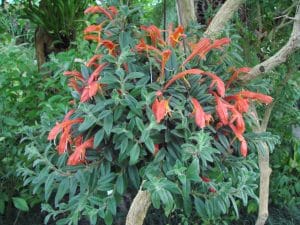 In addition to the popular Columnea microphylla, the following species stand out: Columnea hirta, Columnea kewensis, Columnea gloriosa, Columnea schiediana and Columnea aurantica.
In addition to the popular Columnea microphylla, the following species stand out: Columnea hirta, Columnea kewensis, Columnea gloriosa, Columnea schiediana and Columnea aurantica.
The Columnea Microphylla is the species that best suits as a hanging plant, as long as it grows in suitable pots, or it also assumes the modality of a creeping plant with great coverage in soils, as the Columnea hirsuta does.
Its stems are long and bear evergreen, rounded opposite leaves. In the same way, colorful orange, red or purple flowers appear in the axillary area, which have curious tubular shapes.
This visual spectacle has given La Columnea well-earned fame, both in spring and summer, whose massive orange and red flowers hanging from their long stems recall the movement in the water of «golden carp» fish, with an overflowing effect that seems to make these happy tubular flowers jump out of the pot so strong that they can also give us their happy colors in autumn.
Sometimes, flowering lasts until the arrival of winter.
An outstanding characteristic is linked to its malleable, very flexible stems that are born with such a firmness that allows them to grow and then fall, like a waterfall, a true refreshing visual spectacle that you can make the most of.
Temperature
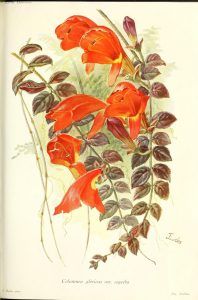 Requiere vivir en ambientes cálidos, entre 20 a 22 °C, pero en la temporada de floración la temperatura debe discurrir entre unos 13 a 16 °C.
Requiere vivir en ambientes cálidos, entre 20 a 22 °C, pero en la temporada de floración la temperatura debe discurrir entre unos 13 a 16 °C.
Las heladas son su punto débil. La Columnea sencillamente no nació para soportar temperaturas bajo cero grados centígrados. Procura siempre no exponerla más allá de 10°C, su límite inferior.
Luz
La Columnea Microphylla admite vivir tranquilamente en sitios de interior muy bien iluminados, siempre que la incidencia de los rayos solares sea indirecta y de corrientes secas o frías.
Coloca la maceta en una zona sombreada de tu hogar y verás cómo rápidamente se desarrollará tu Columnea.
Sustrato y Abono
En términos generales, casi siempre esta planta se cultiva en macetas altas o colgantes a fin de lograr que sus tallos avancen a plenitud, porque siempre crecen hasta pender varios metros hacia abajo. Pero este recipiente donde vivirá tu Columnea ha de prepararse previamente con una mezcla de tierra margosa con turba.
En verano y otoño es oportuno brindarle un fertilizante mineral que la alimente. Busca en el mercado aquellos que no contengan calcio y aplícalo cada 30 días.
El sustrato, no lo olvides, es ligero y ácido.
El trasplantesiempre debe hacerse una vez haya finalizado la floración, cuando desees darle más espacio para crecer en maceta.
Riego
Suelos inundados o encharcados no son recomendables para ninguna planta. La Columnea no es la excepción.
The land must be permanently moistened, so that this plant does not lose its ability to absorb water to keep its leaves and stems alive.
If you see the leaves withered or that they begin to turn yellow, it is due to lack of water.
Did you know…When the irrigation is abusive then you will see the flowers fall before time. Use the following technique: water the plant slowly, with a rain-type watering can once a week in summer and every 15 days in winter, the plant’s rest time, until the new flowering stage occurs.
You can also spray its leaves when the ambient humidity drops, or you will notice that they begin to look wrinkled. That is an indication that you urgently need to hydrate. Do not wet, yes, never your flowers because you will damage them a lot.
The soil will always be oxygenated in this and any other plant if the quality of the irrigation is optimal. The appearance of fungi, fall of its flowers and damage to its leaves are also avoided. Stir the substrate with a pitchfork from time to time and you will achieve these results.
The irrigation water must be warm and free of lime, with a high level of environmental humidity. When the environment is dry, put the entire pot in another larger container, placing wet stones or moistened peat in its tray.
Finally, take great care of it from attacks by bugs such as aphids, although it is usually quite resistant and, therefore, it is one of the best hanging species in the entire world.
Tillandsia or Air Plant
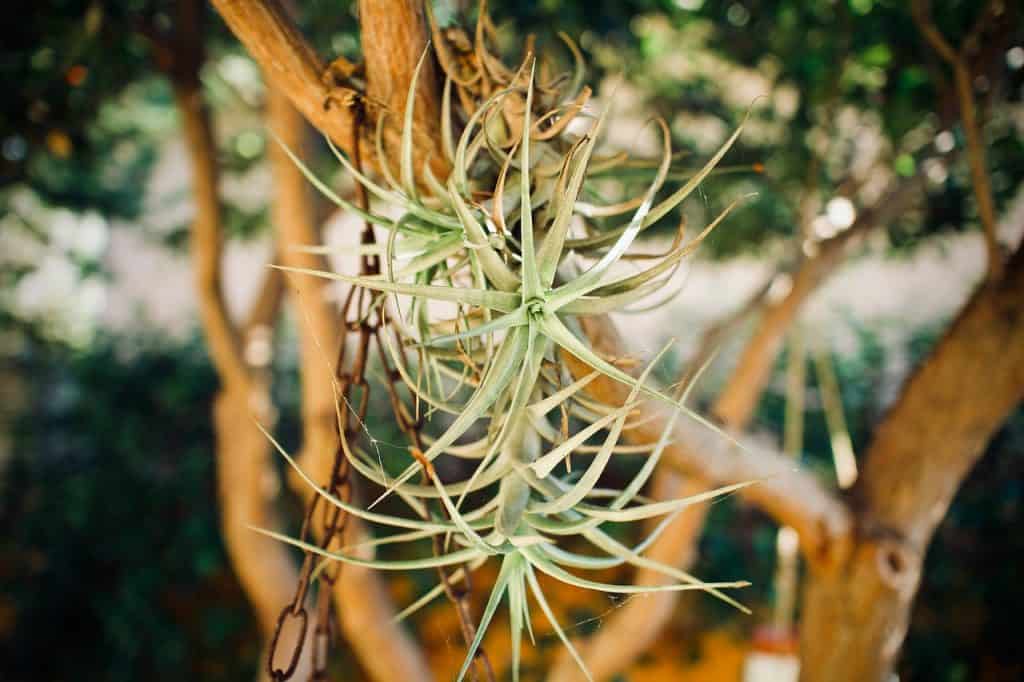
Indoor hanging plants usually require constant care and watering. However, not all of them are like that.
Coming from the American continent, the so-called Air Plant or Tillandsia, is another versatile plant species that thrives in deserts and forests.
It even grows in its natural habitat on tall trees. They are also called Carnations of the air, very easy to grow, so if you are entering the world of gardening, do not miss the opportunity to grow a beautiful specimen of the Tillandsia.
It is not very demanding. So much so that it grows the same on stones, trees, crystals, trunks and even metal supports, thanks to the fact that it does not develop a root to live. It is a completely aerial species, an epiphytic plant , which can survive tied or embraced to another larger species.
An example of its high resistance and versatility is that it can be kept alive inside a decorative glass globe that gives it good humidity. Or let her cuddle up to a metallic copper circlet. The effect it will produce will surely be sensational.
It achieves this because it does not have roots, but a kind of hooks or hooks that stick everywhere.
Temperature
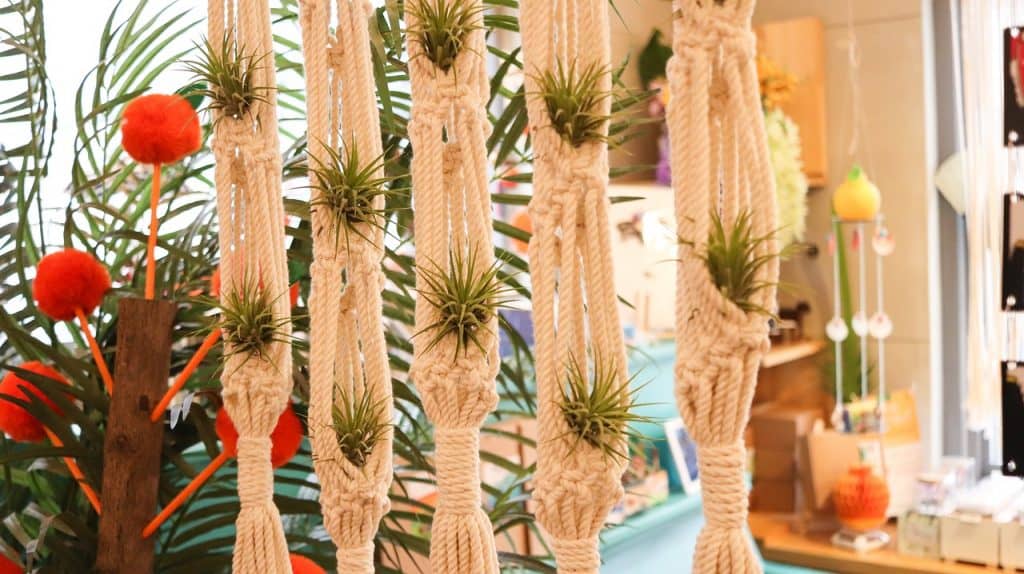 It survives both indoors and outdoors.
It survives both indoors and outdoors.
Family of bromeliads and orchids, the Tillandsia grows slowly, but always prefers high humidity and a temperate climate, given its American jungle origin.
One of the key points for the cultivation ofthis plant lies in the temperature that must prevail when it lives in closed spaces.This plant supports high temperatures, up to 30°C, but under certain conditions. High humidity is one of them.
Another vital recommendation is to keep it away from heat sources from heating systems. And cold drafts too.
But let’s be clear: very low temperatures, icy gales will kill it. It is ultra sensitive to cold and frost. So your body doesn’t work when temperatures are below 10°C. Remember that the tropics are their natural habitat. A harsh winter prevents taking it out to receive light under controlled conditions.
Light
Despite its tropical origin, it should never grow in direct sunlight.
But it is important that by having it indoors we can find a lighted place in semi-shade for it. Take extreme care in summer because it is used to growing in the shade of a large leafy tree, in its original habitat.
Substrate and Fertilizer
Gardening experts recommendthe application of a fertilizer for orchids.Dilute it in a proportion of 25%, once or twice every month. This nutrient will help her a lot, in early spring.
If you use any type of substrate, the leaves of your Carnation of the air can burn easily.
Irrigation
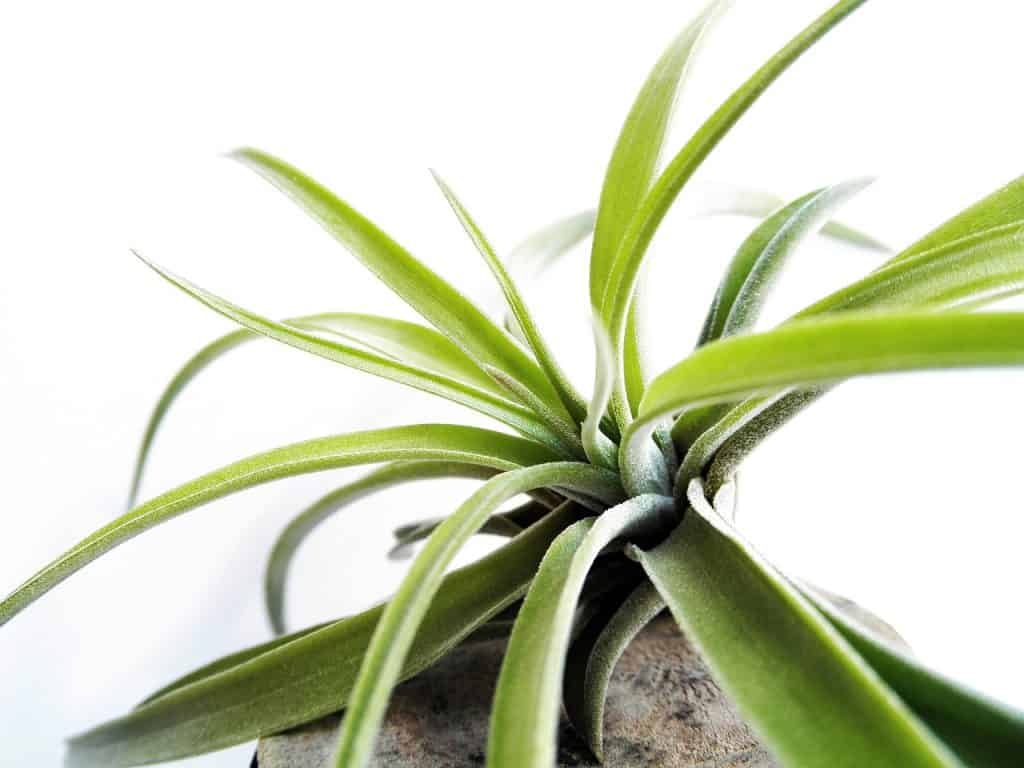 Practically, this plant does not need you to water it. It is very self-sufficient.
Practically, this plant does not need you to water it. It is very self-sufficient.
Por eso se nutre de la atmósfera que la circunda. Basta con pulverizarla con agua de vez en cuando una vez por semana, logrando de esta forma que sus hojas queden impregnadas del rocío. Su exótica belleza resaltará ante los ojos de todos.
Una terraza te dará fama de excelente cultivador de los Claveles del aire.
Nada mejor que regarla con agua de lluvia, la más limpia de todas. Si tienes esa posibilidad, hazlo sin excesos.
And if you venture into the world of vertical gardens, this plant will do wonders with its aerial abilities. And you should not, in these environments, worry too much about her. Remember that this type of plant is fed by its leaves. A liquid fertilizer that you add to the leaf sprayer will be more than enough for her.
Careful with this:The following must be taken into account: if you live in a dry climate, the humidity conditions must always be favorable, so taking care of this aspect will be strictly complied with, or it will suffer a lot. In summer, these risks practically have to be daily.
In winter, on the other hand, watering will be spaced 3 or 4 days apart, because remember that indoors, the use of air conditioning or heating systems tend to dry out the environment.
A piece of information that will help you regulate the intensity of irrigation is provided bythe change in the coloration of the leaves after receiving the water,which indicates that the plant is not receiving the moisture it needs.
You can also use the immersion method, when it comes to caring for large specimens. Use a large container and soak them for 20-30 minutes, so that they absorb all the water they need.
But if it has been grown in a glass sphere, you cannot water it inside because you will contribute to its rot by inconveniently raising its ambient humidity.
Enjoy the benefits that this unique aerial plant gives you, in exchange for very little.
bird’s nest
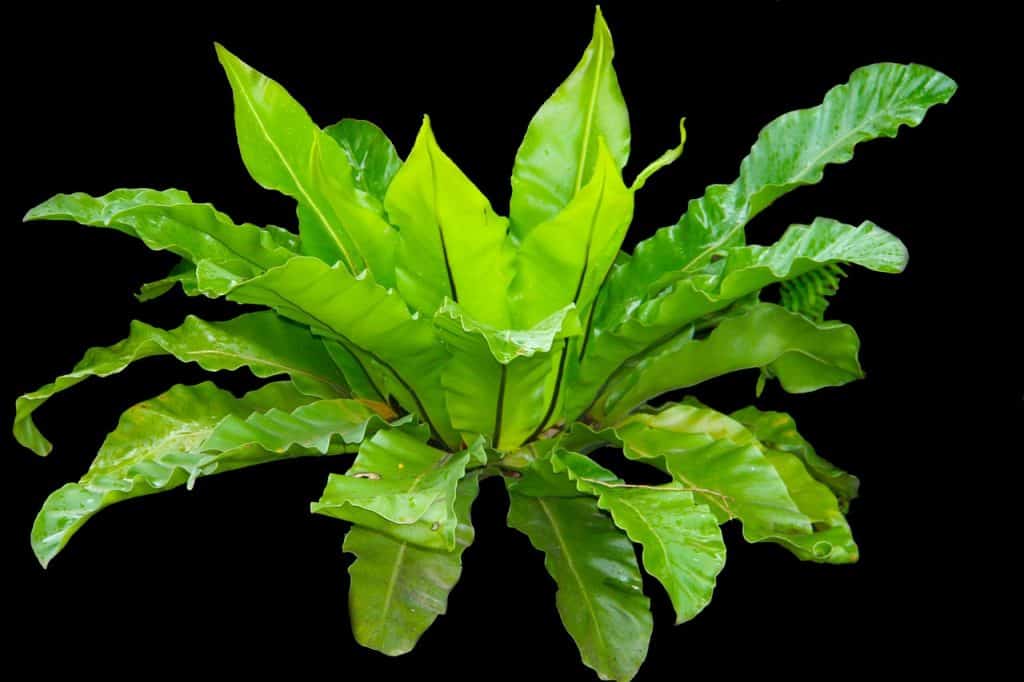
The Bird’s Nest, native to the Australian rainforests, is a fern with beautifulleafy leaves that take the form of a crown.

![Photo of Forsythia: [Planting, Care, Irrigation, Substrate, Pests and Diseases]](https://www.complete-gardening.com/wp-content/uploads/2022/08/forsythia-planting-care-irrigation-substrate-pests-and-diseases-390x220.jpg)
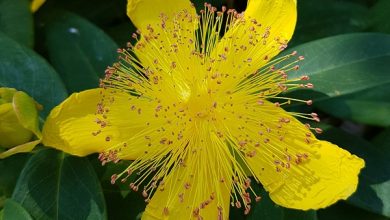
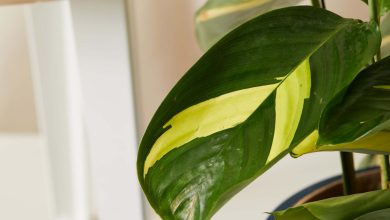
![Photo of Strelitzia: [Characteristics, Planting, Care, Irrigation and Substrate]](https://www.complete-gardening.com/wp-content/uploads/2022/08/strelitzia-characteristics-planting-care-irrigation-and-substrate-390x220.jpg)